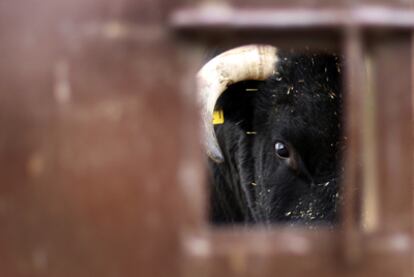Where a bull's eye means genetic perfection
The future of Madrid's fighting 'toros' is being protected on a ranch open to the public
In the pigeon loft, now converted into a cozy room, you can hear water boiling in an electric coffee machine. On the table is a tray of pastries. The enormous head of a bull that weighed 1,200 kilos (when it still had its body attached) rests next to a fireplace. He was called Carretero, the plaque reads, and he was the first big fighting bull to frolic around the Riosequillo ranch, surrounded by a harem of cows. Carretero could mate over 700 times a year, a figure to intimidate any other bull that came here with ideas above his station.
"He was an excellent animal," says, pike in hand, veterinarian Juan José Urquía, who wanders round the ranch situated in Buitrago de Lozoya, in the north of the Madrid region.
Urquía heads up the technological research center that is looking to improve the genetics of the Iberian Avileña-Negra breed, native to the mountains of Madrid, in order to increase the prestige of the region's cattle ranches. If they make an appointment (91 868 09 50), anyone who likes animals and the countryside can spend an entertaining morning visiting this rural laboratory.
The ranch was registered in the breed's genealogical book in 1979, when the now-defunct Madrid Provincial Delegation bought it from private hands. Urquía has spent the morning walking among the cattle, under a leaden sky. He knows several of the beasts by name. He strokes the back of one called Javier, apparently oblivious to the pair of horns in close proximity to his ribs. "This one is very good. There are others with worse characters," he explains.
Each one of the 50 cows grazing on the ranch's 157 hectares of land is registered and numbered according to its date of birth and family details. They all look calm until they hear a tractor approaching. "Lunchtime," Urquía says. A farm manager gets into a cart and throws hay into small piles with a fork, bit by bit forming a circle. The dominant cows take the best piles and the others, such as the one with a broken horn, have to sort themselves out as best they can. The cows can be fertile for 20 years and the diameter of their pelvises facilitates calving. Urquía is used to rummaging in the bushes to find calves that their mothers try to hide.
The three stud bulls - Cenicero, Guapo and Facoquero - are kept apart. They look and snort at one another through the fences. The trees have lost their bark from all the scratching the bulls, which weigh over a ton, do against them. They look defiant, but go sleepy when stroked with a scratcher. The survival of the breed is hanging on their horns.

Tu suscripción se está usando en otro dispositivo
¿Quieres añadir otro usuario a tu suscripción?
Si continúas leyendo en este dispositivo, no se podrá leer en el otro.
FlechaTu suscripción se está usando en otro dispositivo y solo puedes acceder a EL PAÍS desde un dispositivo a la vez.
Si quieres compartir tu cuenta, cambia tu suscripción a la modalidad Premium, así podrás añadir otro usuario. Cada uno accederá con su propia cuenta de email, lo que os permitirá personalizar vuestra experiencia en EL PAÍS.
¿Tienes una suscripción de empresa? Accede aquí para contratar más cuentas.
En el caso de no saber quién está usando tu cuenta, te recomendamos cambiar tu contraseña aquí.
Si decides continuar compartiendo tu cuenta, este mensaje se mostrará en tu dispositivo y en el de la otra persona que está usando tu cuenta de forma indefinida, afectando a tu experiencia de lectura. Puedes consultar aquí los términos y condiciones de la suscripción digital.








































